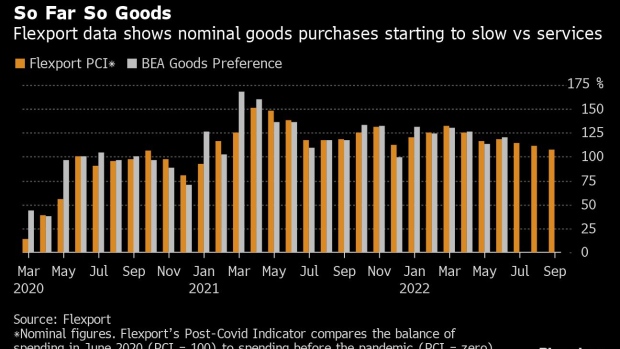Aug 16, 2022
The American Splurge on Merchandise Is Grinding Slowly to an End
, Bloomberg News

(Bloomberg) -- For two years, the pandemic spurred Americans to buy more goods at the expense of services. That shift -- which boosted everything from container shipping rates to sales of Peloton exercise bikes -- looks to be grinding slowly toward an end.
Flexport Inc., a San Francisco-based freight forwarder, developed a gauge that sets zero as the baseline for pre-Covid spending and June 2020 at a level of 100% that the company used to mark the start of the work-from-home economy.
The measure, designed to track the actual goods-versus-services consumption balance from the US Bureau of Economic Analysis, has hovered well above 100% for much of the past two years as US households splurged on merchandise and cut back on services such as restaurants and travel.
The latest reading of Flexport’s Post-Covid Indicator released Tuesday shows it falling for a third straight month, to 107% in September -- the lowest level since January 2021 and well off its peak of 151% set in April last year.
When adjusted for inflation, the return to normal spending behavior is even sharper, driven by demand relative to services for non-durable goods such as clothes and personal-care products. That figure is expected to come close to its pre-pandemic level, hitting 18% in September while durable goods consumption hits 90%, according to Flexport calculations.
“Spending preferences are heading back to pre-pandemic levels,” said Chris Rogers, a supply-chain economist with Flexport in London. “It has been taking a long time to get there -- this isn’t something that turns on a dime. It’s going to take much of the rest of this year to get even close to the old normal.”
©2022 Bloomberg L.P.


